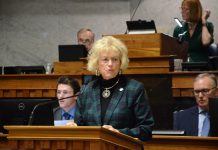“Today’s action is an important step to further President Trump’s regulatory reform agenda by providing meaningful incentives for investment that prevents hazardous air pollution,â€Â said EPA Administrator Andrew Wheeler. “This rule, which follows on a 2018 guidance memorandum, will end regulatory interpretations that discourage facilities from investing in better emissions technology.â€
“EPA’s previous OIAI policy was a strong example of a counterproductive regulation, imposing costly requirements that hurt economic growth while also providing no incentive for businesses to reduce hazardous emissions,â€Â said U.S. Senator John Hoeven (ND). “This new rule is exactly the kind of regulatory relief that we’ve worked with the administration to provide, as it supports businesses in upgrading their operations with the latest technology, empowering a stronger economy and better environmental stewardship.â€
“The ‘Once In, Always In’ policy was a clear example of counterproductive regulation. It discouraged industry from making improvements to decrease hazardous air pollutants. I applaud Administrator Wheeler on finalizing the MM2A rule. It will provide clarity in regulation, lead to cost savings, and encourage facility upgrades that will benefit air quality,â€Â said U.S. Congressman Morgan Griffith (VA-09).Â
The Clinton-era “once in, always in†policy discouraged facilities from modernizing and implementing voluntary pollution abatement and prevention efforts. This rule allows those “major sources†that have taken enforceable limits to reduce their emissions to reclassify as an “area source.†States and stakeholders voiced concern that the “once in, always in†policy discouraged voluntary pollution abatement and prevention efforts. By removing unnecessary monitoring, recordkeeping and reporting associated with being a major source, this rule will relieve unnecessary compliance and financial burdens from regulated entities and encourage other sources to reduce emissions. Emissions requirements will not change for existing major sources that choose not to reclassify. Sources that choose to reclassify will be subject to any applicable “area source†requirements.
EPA estimates that this rule will result in cost savings when compared to the agency’s previous “once-in, always-in†policy. EPA estimates a potential cumulative savings of $16.1 million in the first year and $90.6 million (in 2017 dollars) in following years.
With this final rule, EPA has saved Americans a total of approximately $95 billion in unnecessary regulatory costs under President Trump.



